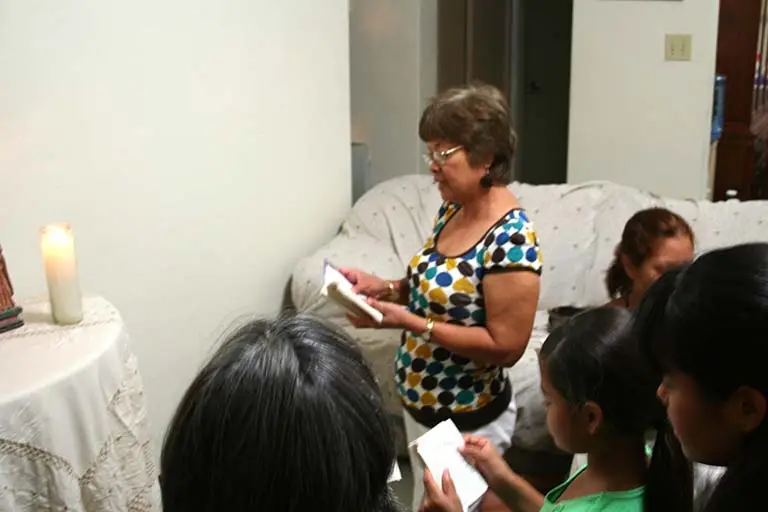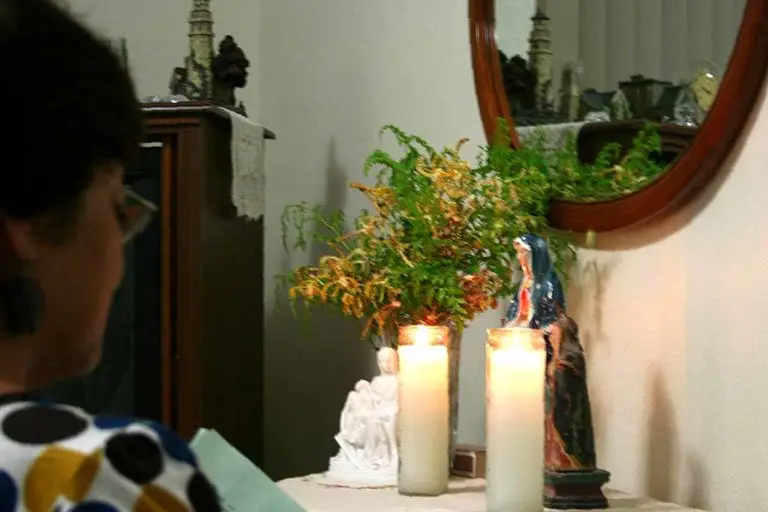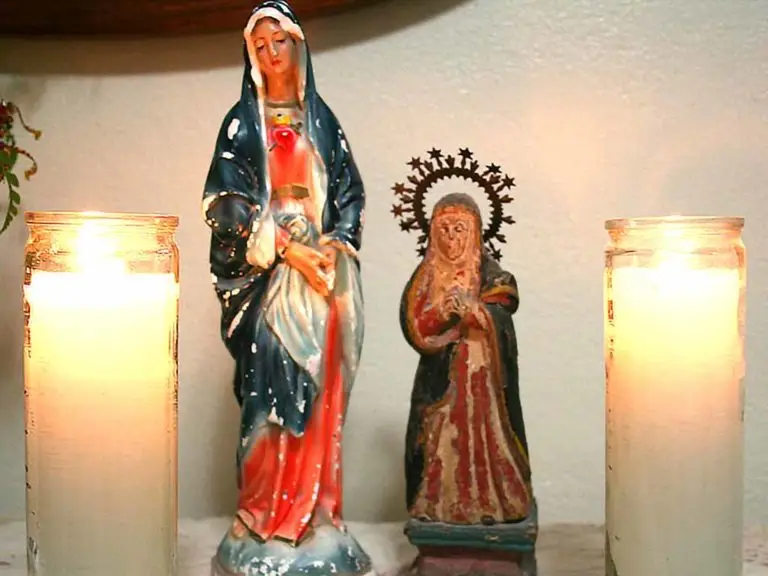Nobena: Novena (Catholic Devotional Prayers)



Table of Contents
Share This
Nine day rosary and devotional prayers
The nobena, or novena, is a series of devotional prayers said over the course of nine days that are associated with the various feasts of the Catholic Church year. The purpose of a novena is to make a particular request through the intercession of the honoree for whom the novena is named. Novenas traditionally were performed both as public and private devotions for the nine days preceding the feast day of the Mystery, saint or aspect of Mary or Jesus being honored.
The devotional novena, a product of the popular piety of the Middle Ages, reached a climax within the Catholic Church in the 1800s, and many different kinds of novenas emerged with special plenary indulgences granted by the Pope. Novenas, though, were also useful for teaching people prayers in preparation for important liturgical celebrations and enhancing the faith experience. Of all the rituals in Catholicism, it can be argued that the novena was so acceptable among the CHamorus because of its potential for familial solidification and strengthening of family ties even between generations.
The first nobenas prayed by Chamorro/CHamorus seem to have been mainly in the Spanish language. Later, the German Capuchins in Saipan and the Spanish Capuchins on Guam translated many European novenas into CHamoru, with Pale (Padre or Father) Roman Maria de Vera, a Spanish Capuchin missionary on Guam, translating the vast majority of CHamoru nobenas.
The prayers of a nobena basically include the rosary and devotional prayers to the novena’s honoree. A rosary is a group of prayers to the Virgin Mary that are counted on a set of special beads. The formal practice of praying a novena, along with the celebration of mass, saints’ feast days and solemn processions, was introduced to the CHamorus by the Spanish Jesuit missionaries following the conquest of the Marianas. The relocation of CHamorus from their homes to six villages facilitated the indoctrination of the surviving CHamorus with the Catholic faith. The liturgical celebrations of the Catholic calendar was then incorporated into the daily lives of the CHamoru people, most notably through their participation in the nobena and fiesta activities.
The more public nobenas are closely tied to fiestas offered in celebration of village patron saints’ feast days. Almost every village on Guam has a patron saint whose feast day is celebrated each year. For example, the people of the village of Barrigada celebrates the feast day of San Vicente, their patron saint, on April 21st, and the village of Dededo celebrates the feast of Santa Barbara on December 4th.
Led by a techa
The nine days of public prayer and rosaries are led by a techa, or prayer leader, and end with a formal procession and a Mass, usually on a Saturday, with the traditional sharing of a meal called the na’taotao tumano. The people of the host village provide the food which is served on the church grounds in the social hall or nearby community center. Nowadays, many families will hold their own fiesta dinners within their homes to celebrate with relatives and friends, including those visiting from other villages.
The more personal nobena offered in the private spaces of the family home is the nobenan i promesa. These novenas are offered to honor saints from whom favors were granted. Some families hold these individual nobenas every year. They usually are passed on from mother to eldest daughter and are a sign of continuity, faith and devotion to the honoree of the promesa.
Favored nobenas
When anthropologist Laura Thompson studied CHamoru culture on Guam in the 1930s, she documented four solemn novenas celebrated by the CHamorus every year, the two most important ones being the Nobenan Promesa pat i Nobenan i Linao, or novenas of security or earthquake. These novenas originated following destructive earthquakes in April 1858 and September 1902 and were offered in thankfulness and hope for continued protection from natural disaster. The other two novenas were the All Saints’ novena on November 1st, and the Nobenan la Purisma in honor of the Immaculate Conception on December 8th.
Today, the more popularly celebrated novenas include the Lenten novena in the spring in commemoration of Jesus’ death, resurrection and ascension into heaven, the Kurason de Jesus, or Heart of Jesus, a summertime novena, the Nobenan Santa Maria in December for Guam’s patron saint, the Virgin Mary, and the Nobenan Niñu, also in December, in honor of Christ’s birth.
The Nobenan Niñu is held during the Christmas season with the last day ending on either Christmas Eve, Christmas Day, New Year’s Eve, New Year’s Day, or on Three King’s Day in early January. It is most often celebrated within individual family homes. Like other promesas, this nobena is generational and often passed through the female line from mother to daughter.
Preparing for the nobena may also involve the construction within the household of a bilen, or nativity scene, depicting Christ’s birth. Sometimes the bilen is quite elaborate, with statues of farm animals, shepherds and the three kings in addition to the main figures of the Baby Jesus, Mary and Joseph surrounded by a lush setting of natural and artificial materials. The Nobenan Niñu is said for nine days, and unlike the village church fiestas, is actually much simpler.
Teaching opportunities
The nobena is seen by CHamoru Catholic families as a good opportunity to teach children prayers and songs important to their faith, but the responsibility for following through with the yearly devotional lies largely with the women. Though sometimes individuals may be overwhelmed by the familial obligations associated with novenas, or even dislike the idea of “praying to statues,” the yearly observance of the nobena overall helps to unite and strengthen familial ties, and are an important part of CHamoru Catholic religious life.
Nobenan e-Publications
For further reading
Chamorro Heritage, A Sense of Place: Guidelines, Procedures and Recommendations For Authenticating Chamorro Heritage. The Hale’-ta Series. Hagåtña: Department of Chamorro Affairs, Research, Publication and Training Division, 2003.
Crumrine, N. Ross “Praying and Feasting: Modern Guamanian Fiestas.” Anthropos 77, no. 1-2 (1982): 89-111.
Perez-Iyechad, Lilli. “Novenas and Fiestas: Gratitude Portrayed.” In An Historical Perspective of Helping Practices Associated with Birth, Marriage and Death Among Chamorros in Guam. Lewiston: Edwin Mellen Press, 2001.
Spoehr, Alexander. Saipan: The Ethnology of a War-Devastated Island. 2nd ed. Saipan: Commonwealth of the Northern Mariana Islands Division of Historic Preservation, 2000.
Taves, Ann. The Household of Faith: Roman Catholic Devotions in Mid-Nineteenth-Century America. Notre Dame: University of Notre Dame Press, 1986.
Thompson, Laura M. Guam and Its People. With a Village Journal by Jesus C. Barcinas. 3rd ed. New Jersey: Princeton University Press, 1947.
